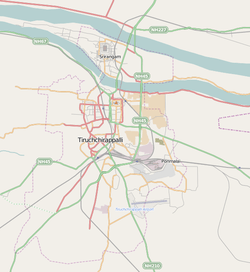Uraiyur
| Urayur Woraiyur | |
|---|---|
| Trichy city | |
 Urayur | |
| Coordinates: 10°49′41″N 78°40′42″E / 10.82806°N 78.67833°E | |
| Country |
|
| State | Tamil Nadu |
| Time zone | IST (UTC+5.30) |
| List of Chola kings | ||||||||||||||||||||||||||||
|---|---|---|---|---|---|---|---|---|---|---|---|---|---|---|---|---|---|---|---|---|---|---|---|---|---|---|---|---|
| Early Cholas | ||||||||||||||||||||||||||||
| Interregnum (c. 200–848) | ||||||||||||||||||||||||||||
| Medieval Cholas | ||||||||||||||||||||||||||||
|
||||||||||||||||||||||||||||
| Later Cholas | ||||||||||||||||||||||||||||
|
||||||||||||||||||||||||||||
| Chola society | ||||||||||||||||||||||||||||
Urayur (Tamil : உறையூர்) is a area of Tiruchirapalli in Tamil Nadu, India. It was the capital of the early Cholas, who were one of the three main kingdoms of the ancient Tamil country. Sometimes spelled as Uraiyur, this location is also known as Thirukkozhi, Nikalaapuri, Uranthai, and Kozhiyur. It has a history dating back to before 2 BCE. There is definite mention of the Cholas, whose founder was Vijayalaya and their capital in Ashokan inscriptions in Orissa pushing back the antiquity of the Cholas as well as Uraiyur to 272–232 BCE, which was the period of Ashoka (ca. 304–232 BCE) who was ruler of the Maurya Dynasty of Pataliputra (modern Patna). Inscriptions and rock edicts of Ashoka and the Satavahanas describe Urayur as "the citadel and centre of the Cholas".Uraiyur was ruled by karighazhan cholan.
History
Uraiyur is also mentioned as the capital of the ancient great Chola King Karikalan before the 1st century CE until the dynasty was revived by Vijayalaya Chola c. 850 CE. The Cholas were one of the four great Tamil dynasties; (Pallavas, Cheras and Pandyas are the other three) who ruled over the Tamil country in South India, the Konkan coast, Deccan Plateau and during the peak reached beyond the Narmada up to the Ganges–Damodar delta from early antiquity.
The word Urayur in Tamil literally means "the residence". Urayur was an ancient Chola city with a fortress and city wall on the southern banks of the river Kaveri. The Imperial Cholas of the 9th century CE and later made Tanjavur their capital, and Urayur slowly lost its place in the Chola administration.
The reason why it is also known as Kozhiyur is due to the legend of a cock attacking the elephant of the king. He was taken aback for a moment but then decided to build his empire around that place after he realized the cause for the boldness was the soil.
Temples
Several notable temples are situated here:
- Thanthoneeswarar Temple
- Panchavarnaswamy Temple
- Sri Azhagiya Manavala Perumal Temple
- Vekkali Amman Temple[1]
Notes
- ↑ V., Ganapathy (4 November 2004). "Siva temple of yore". The Hindu. Retrieved 2013-09-09.
References
- Nilakanta Sastri, K.A. (1935). The CōĻas, University of Madras, Madras (Reprinted 1984).